Every train needs a box car. At least before specialty rail cars took over much of the rail traffic. Box cars carried most everything inside their enormous bodies. As time went by, the time and cost to unload a box car with limited door access justified more cost effective and productive rail cars. As these specialty cars like autoracks, lumber cars, multimodal and others become more common, there is less demand for boxcars and fewer are being used. Today, box cars are seldom seen on a train and are no longer the prevalent railcars cars on a train, but back in the day, few trains did not have a long line of them.
Lionel Trains always produced model trains reflecting the railroad industry. This meant that Lionel had to have boxcars in their lineup. And they did. Lionel produced several body styles in the postwar period (1945-1969). The earliest were metal bodies like prewar items. Soon, injected molded plastic models were made. And while all styles were well loved and popular, the most well-known and well-studied is the large (10 ½ inch 6464 series) box car, first listed in the 1953 catalog. This body style continued through the end of the postwar period in 1969.
There were less than 25 different railroad names over this period as measured by different SKU units produced. Yet because of difference in production over time, there are hundreds of verified significant variations in these few road names. Some changes are minor, some a little more noticeable.
The common elements in the 6464 series box cars:
- All 6464 cars had a unique suffix (ie 6464-125).
- All 6464 cars are 10 ½ inches long.
- All 6464 cars have two operating doors with metal door guides.
- All 6464 cars have a stamped metal frame.
- All 6464 cars have operating knuckle couplers at both ends of the car.
- All 6464 cars have bar end or AAR trucks.
- All 6464 cars are attached to the metal frame with a screw.
- All 6464 cars came in sets, and some were offered for separate sale.
- All 6464 cars were sold in boxes (not all box types are the same)
For some, getting one of each road name is considered a complete collection. For those with more curiosity, seeking out and finding the variations is a more rewarding effort. This web site starts to define the many variations. Each image in this section is of one of the variations. To an untrained eye, many variations look the same, but to the serious investigator, there are many differences, some minor, some major. One area of interpretation is the color of the paint. It is hard to determine and measure color differences between individual examples and given the variability of digital images, color variations are not specifically recognized in this study, but for some, even a slight variation is a significant factor. Areas to look at in this presentation are:
- Door guide rivets
- Door color
- Construction and specific build details of the coupler
- Style of Truck assembly
- Activation mechanism of Knuckle coupler
- Differences in side decorations including position, content and wording
- Differences in molds – and mode types. This is defined by specifics in the mold and changes over time. Examples are in rivet positioning and in reinforcement under the top catwalk.
- Box size and box details – the box details can indicate when a product was produced.
This site believes all examples are valid general production by Lionel and those listed here were available for sale to the public. Be advised, there are examples of reconfigured units and in the worst cases, misleading changes to create a unique variation.
Dennis Devito
TYPE 1
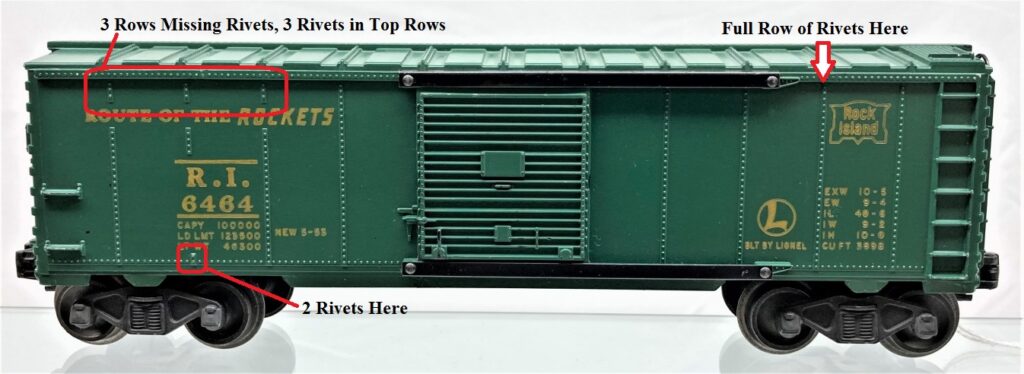
The Type 1 was the first 6464 body type and was introduced in1953. As shown above, rivets were left out of the first three rows on the left near the top as well as the second row from the left further down. In all cases of rivets being left out, Lionel did this to allow printing of lettering and graphics on a flat surface. The fastest way to identify a Type 1 is to see a full row of rivets in the second row from the right.
Below are pictures of Type 1A, 1B and 1C showing the different inside roof detail.
TYPE 1 VARIATIONS

The Type 1A has roof detail and no gussets as seen above

The Type 1B has added gussets as seen above near each of the small circular mold ejection pin marks.

The final, Type 1C, has gussets but a smooth interior roof. This is the most common variation.
TYPE 2
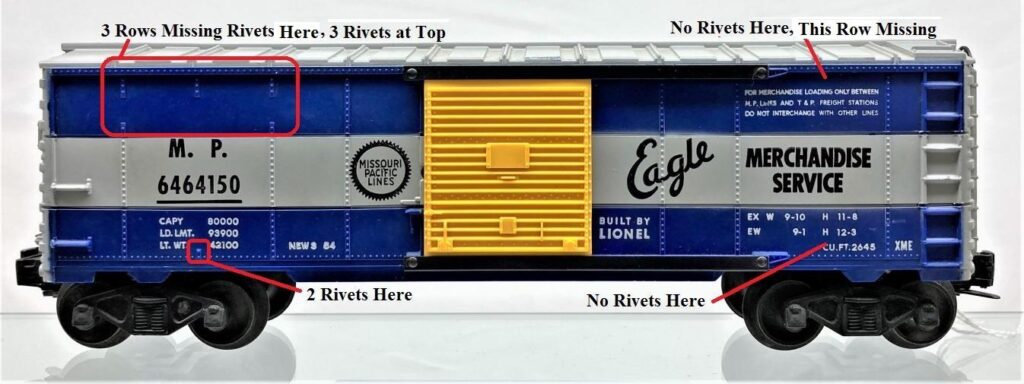
Introduced in 1954, The Type 2 has additional rivets removed to accommodate the graphics on the new cars introduced that year. The left side has the middle rivets in second row from the left removed, as well as the entire second row from the right is gone. Below are the two variations of the Type 2.
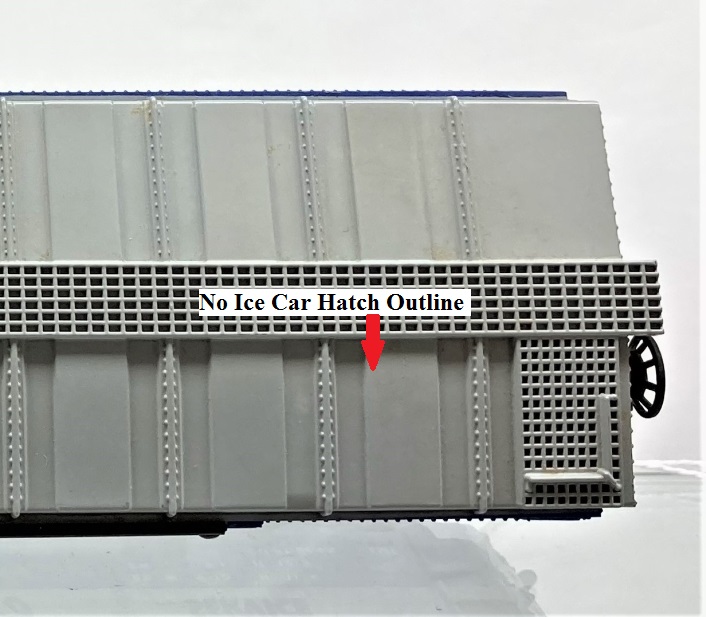
The first Type 2 cars had no “Ice Car Hatch” outline shown above as they were produced prior to the 6352 Ice Car in 1957 which required a modification to the mold. For standard 6464 bodies after that date, a plug was placed in the mold, leaving an outline as shown below.
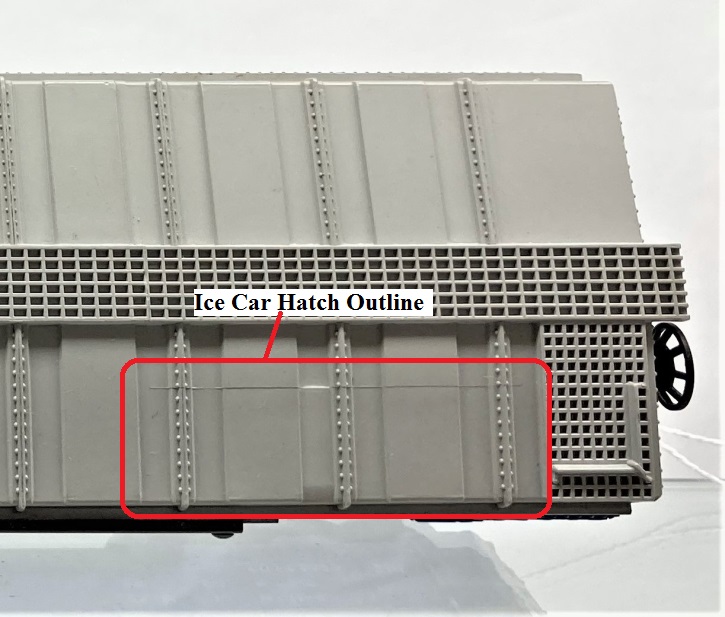

Appearing only on both Types 2A and 2B starting around 1955.
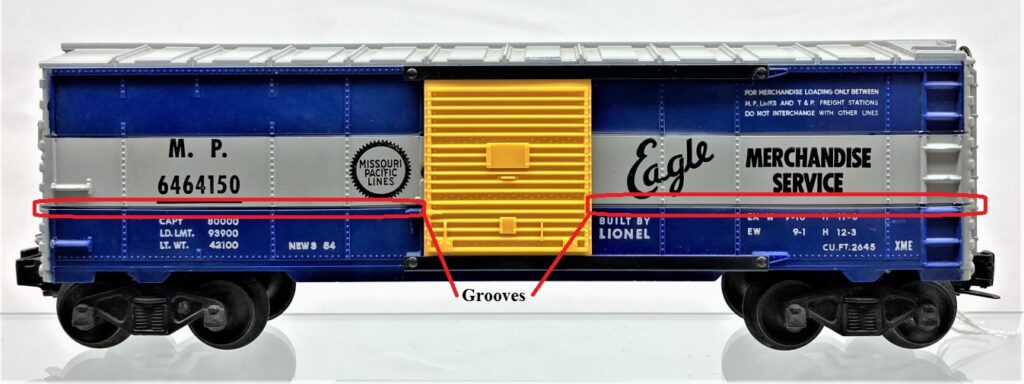
As shown above, some cars like the -150 had a groove cut into the sides to aid in paint masking. This was a post-mold operation, not a mold change. Cars can be found with or without this groove.
TYPE 3

The Type 3 was introduced some time in late 1958. The roof hatch outline was gone. The interior of the roof now has ribs. The left side is the same as Type 2. Two rivets return at the top and bottom of the second row from the right.
TYPE 4
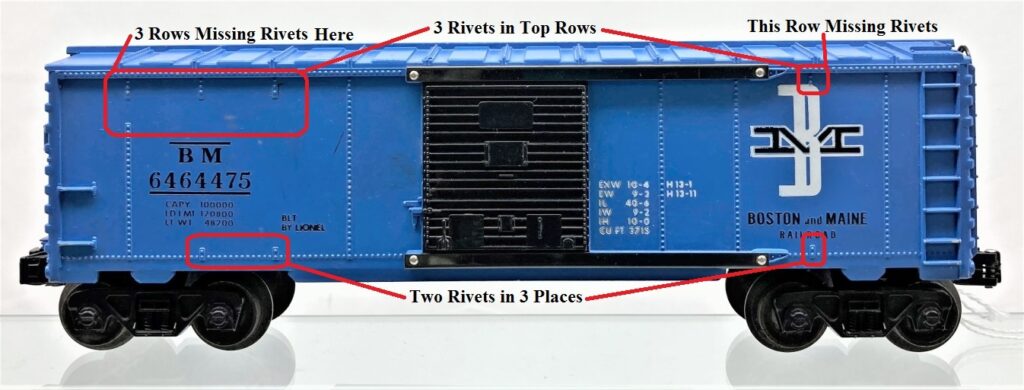
Beginning in 1960 and through the end of the postwar era in 1969, the Type 4 body was used. Identical to the Type 3 with interior roof ribs, no ice hatch outline, and the right side with only two rivets top and bottom in the second row. The left side now has all but two rivets top and bottom in both the second and third rows from the left.
Where would you like to go next ?


